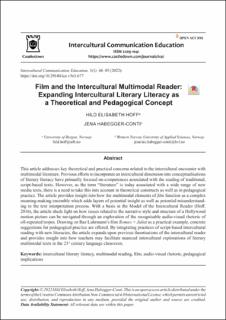Film and the intercultural multimodal reader: Expanding intercultural literary literacy as a theoretical and pedagogical concept
Journal article, Peer reviewed
Published version

Åpne
Permanent lenke
https://hdl.handle.net/11250/3043456Utgivelsesdato
2022Metadata
Vis full innførselSamlinger
Originalversjon
Intercultural Communication Education. 2022, 5 (3), 68-85. https://doi.org/10.29140/ice.v5n2.677Sammendrag
This article addresses key theoretical and practical concerns related to the intercultural encounter with multimodal literature. Previous efforts to incorporate an intercultural dimension into conceptualisations of literary literacy have primarily focused on competences associated with the reading of traditional, script-based texts. However, as the term “literature” is today associated with a wide range of new media texts, there is a need to take this into account in theoretical constructs as well as in pedagogical practice. The article provides insight into how the multimodal elements of film function as a complex meaning-making ensemble which adds layers of potential insight as well as potential misunderstanding to the text interpretation process. With a basis in the Model of the Intercultural Reader (Hoff, 2016), the article sheds light on how issues related to the narrative style and structure of a Hollywood motion picture can be navigated through an exploration of the recognisable audio-visual rhetoric of oft-repeated tropes. Drawing on Baz Luhrmann’s film Romeo + Juliet as a practical example, concrete suggestions for pedagogical practice are offered. By integrating practices of script-based intercultural reading with new literacies, the article expands upon previous theorisations of the intercultural reader and provides insight into how teachers may facilitate nuanced intercultural explorations of literary multimodal texts in the 21st century language classroom.
